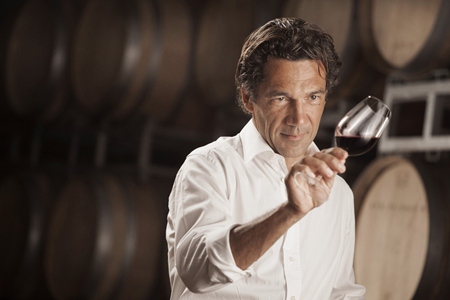Both the wines this week come from the Languedoc Roussillon area of sunny South West France, tucked down in the corner with Spain to the south and the Mediterranean to the East. It’s wine country. They’ve been making wine in the region for more than 2000 years.
These two Claudeval wines are produced by Domaines Paul Mas, a company with nearly 3,000 acres of owned and contracted vineyards.
 Jean-Claude Mas: a pioneer of the New Languedoc.
Jean-Claude Mas: a pioneer of the New Languedoc.
The present owner, Jean-Claude Mas and the son of the eponymous Paul Mas, has been described as “a pioneer of the New Languedoc” and belongs to the new wave of French wine-makers with a mission to bring to the Languedoc something of its former glory.
Claudeval Blanc 2010 (white) Pays d’Oc, France (Bt. 375 @ Friendship)
As I was pouring this wine into the decanter, I got a lovely whiff of white flowers. It’s a bright gold with greenish tints and I think you’ll be impressed with the delightful and quite complex aroma. Tropical fruit dominates and you’ll easily detect pineapple, melon and citrus smells. In the background, you might detect a touch of mint, menthol and honey.
The wine has a soft and fruity mouth-feel but it’s quite dry and medium bodied. The rich fruit is well forward giving the taste the tiniest hint of sweetness. There’s a touch of soft acidity, which helps to give it body, and the long dry finish has subtle hints of herbs and citrus. It’s a summery sort of wine with a lovely grassy freshness.
But here’s the interesting thing. The wine is a blend of no less than six grape varieties. I want to tell you about them, so sit up and listen carefully, especially those boys shuffling about in the back row. You’re probably familiar with at least two of the grapes, the Sauvignon Blanc (10%) and the Chenin Blanc (5%). However, the blend is dominated by Grenache Blanc (35%) and also includes the little-known Vermentino, Chasan and Mauzac grapes. These days, the Vermentino is becoming popular in the Languedoc Roussillon region but as its name implies, actually comes from Italy. The Chasan is a cross-breed created in 1958 and usually found only in local blended wines and the Mauzac is one of the local lads in South West France.
The six varieties were vinified separately before blending and then fermented for three weeks at a low temperature to preserve the aroma and fruity quality. I’d be happy to drink this on its own even though it has a 13% alcohol content, but it would make a terrific partner for light chicken dishes. But not fish or curries, because these two foods can impart an odd metallic taste to the wine. And yes, I’ve tried, since you asked.
Claudeval Rouge 2010 (red) Pays d’Oc, France (Bt. 375 @ Friendship)
This is a rich garnet red and you’ll notice those leggy rivulets of liquid in the glass that the French poetically refer to as “tears”. They’re partly due to the comparatively high alcohol content (it’s 13.5%), surface tension and the way alcohol evaporates. It’s sometimes known as the Gibbs-Marangoni effect, but I shall spare you the technical details. (That’s a relief – Ed.)
Your nose will be greeted with a basket-full of interesting aromas. You’ll probably pick up black plums first, hints of raspberries, a dash of menthol, spices and a hint of woody pepper. This wine is a blend of Merlot, Syrah, Grenache and Carignan grapes. Although the mouth-feel is quite soft, rich and rounded, the wine has quite an assertive presence. Very much in the French style, the fruit is quite restrained on the palate and there’s a satisfying foundation of tannin that follows through on the dry and herby finish. I think there are hints of licorice too. It’s a medium-bodied wine, very dry, rather elegant yet pleasantly easy to drink.
Incidentally, both these wines come with eminently practical screw-caps. I do wish that more French wine producers would adopt them, because for wines intended for early consumption they’re so much easier than corks.
Now then, before I go, can any of those boys in the back row tell me the names of the six grapes used in the Claudeval white? No. I thought as much. I knew you weren’t paying attention. I shall see the lot of you in my office after school.




